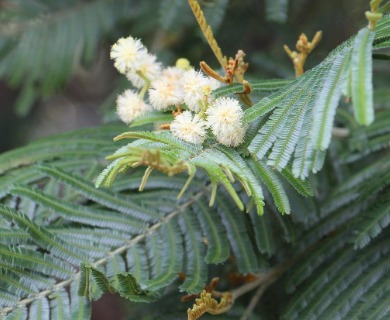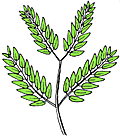Black Wattle
Acacia mearnsii
Pea family (Fabaceae)
Post-Cook introduction
This is a small, handsome, introduced tree with a thin spreading of finely divided leaves, flowers in small light yellow balls, and narrow flattened beadlike pods. To 40 ft (12 ) tall and 10 inches (25 ) in trunk diameter. Bark brown to gray, smooth to finely fissured. Inner bark is light yellow with brown steaks, bitter. Twigs brownish, finely angled, with tiny hairs.

©2013 J. B. Friday
Flower clusters of light yellow balls (heads) 1⁄4 inch (6 ) in diameter, several on short stalks at leaf bases and shorter than leaves. Flowers fragrant, tiny, numerous stalkless in balls, 1⁄8 inch (3 ) long, with tiny five- and and many spreading threadlike separate ending in dot
(pods) are several clustered, 2–4 inches (5–10 ) long, 1⁄4 inch (6 ) wide, flattened, gray brown to blackish, finely hairy, slightly narrowed between seeds, splitting open. Seeds are several, beanlike, 1⁄8 inch (3 ) long, elliptical, dull black.
The wood is light brown with reddish streaks resembling pale koa. It is heavy ( gr. 0.55), hard, and relatively difficult to work. It is not resistant to decay. Elsewhere, the wood is used in turnery and for fuel, and the bark for tanning. It is not used in Hawaii.
Considered a weed in most places in Hawaii, particularly in Kula, Maui, where it is very prolific. Propagated from seeds and easily established. Short-lived, but new sprouts are produced by roots. The Division of Forestry has planted 65,000 trees in the Forest Reserves, primarily at Mokuleia, Oahu and Kula, Maul. The trees at the Kula Forest Reserve were mostly planted in 1938 and 1939 and may be the progenitors of the escapes. Also at Kamuela, Hawaii. Introduced as an ornamental in southern California and other subtropical regions.
Special areas
Kokee, Kula, Tantalus
Range
Native of Australia
Other common names
green-wattle acacia, blackwattle, green-wattle
This species was formerly called Acacia decurrens (Wendl.) Willd.







